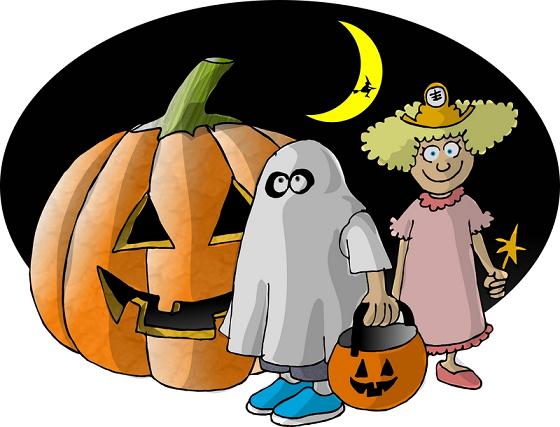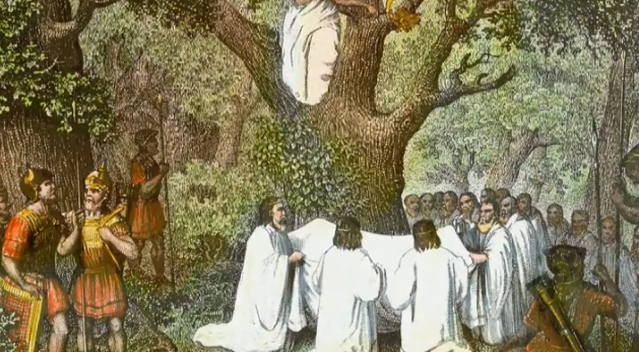Halloween – Part 2 -Comments on History and Wrap Up

My Halloween Comments
As a writer looks over Halloween historical facts or what the historical writers believed to be facts, it is hard to be fully objective . Part of me wants to make purely “academic” observations and part of me wants to try to interpret what I have read through the lens of my experience and my belief set or “worldview”. You can judge with part wins out!
“The Facts” as I can discern them
I. The original rituals were a pagan physical world mixture of post harvest thankfulness (most years) and fears of a difficult winter to survive. They were also mixed with pagan religious spirit world recognition or belief that the spirits of the dead could and would rise to life at this time of year. The Celts feared these spirits and sought to hide themselves from them.
II. The Roman Catholic Church frowned on the pagan religious rituals and so decided to try to inject some Christian theology into the seasonal celebrations. The Church was partly successful but many Celts simply added the Catholic rituals to their own and not making a substitution.
III. The original celebrations were very much adult oriented. From the design of the rituals to their performance the emphasis appears to be mostly adult.
IV. Geographically, the holiday was primarily confined to the northern parts of what we now call the UK for several hundred years. Early American settlers, the Puritans, shunned the pagan/Catholic holiday traditions and gave no recognition to Halloween at all.
V. Then a major world-changing event took place. The mid-nineteenth century Irish potato famine led to mass exodus from Ireland (and to a lesser degree, other nearby countries) with a large number of people coming through United States Customs portals on the East Coast – Boston, New York and Philadelphia, in particular. The Irish brought Halloween with them but they made adjustments to their customs to make them seem more acceptable to the citizens of their newly adopted homeland. My maternal grandfather came from the northern part of Ireland but in the 1890’s, not due to the famine.
VI. In the U. S. there has seemed to be a gradual shift away from adult dominated rituals to youth dominated rituals / emerging variations. For example, the large Celtic bonfires became the glowing jack-o-lanterns. The disguises to confuse the evil spirits became costumes and masks for use in trick or treating or for just plain scary effect – not necessarily connected to any of the traditional evil spirit roaming.
VII. The melting pot of diverse cultures, traditions, and ritual and/or religious celebrations seemingly fostered a gradual secularization of Halloween as the nineteenth century ended and the twentieth century got underway. At the same time, the practice of praying for souls in exchange for cakes was morphing into a secular Trick or Treat “ritual” which drifted more toward destructive tricks than enjoyable treats.
VIII. Somewhere along the line, the entrepreneurial nature of our culture began to craft and shape products and services for the Halloween holiday. This trend accelerated in recent decades/years to the point where Halloween is now the second largest grossing holiday in the annual retail calendar, second only to Christmas.
IX. It is anybody’s guess what all the causes of these adaptations were. As the trickery and horror movie aspects began to dominate in the mid to late twentieth century, the churches began to see a need to reenter the holiday. Fall Festivals, Harvest Celebrations and even small-scale carnival games and rides began to be offered by a growing number of churches as a better alternative to destructive, sometimes violent behavior. In a manner of speaking, we may be coming full circle to the point where pagan (read commercialized) rituals are being opposed with a soft counter attack of church-provided candy and games, with a bit of Christian trimmings along the edges.
How Did I Do?
Well, I’m not sure I stuck to the “facts” or that I covered all the important ones.
What do you think?
Halloween Wrap Up
Well, we have looked at the “facts” of the history of Halloween and made some “objective” comments on the history.
Halloween and made some “objective” comments on the history.
All that remains is to say “So what. What does it mean for me?”
It means different things for different people, of course, so I will be answering the question for myself.
Commercialization Run Wild
First, I object to the commercialization of the holiday. I can’t understand how the retail marketplace has succeeded in making it the second most lucrative holiday to Christmas (and Christmas is surely over commercialized, too). As a boy, I was very content to have a half mask that only covered my eyes and nose and a paper grocery bag to receive treats from neighbors. The major tricks in those days were drawing innocent chalk pictures on peoples’ sidewalks and putting a handful of flour into a stocking and hitting each other with them to leave white marks on our clothes.
Violence
Second, I am troubled at how the intensity and violence of expression have increased over the past few decades. For my generation, the participation in trick-or-treating generally tapered off at 10 – 12 years of age and relatively little was made of the holiday by the older age groups. There was never any mention of any religious meaning to Halloween in my personal experience or in the news media of those days either. More recently, there has been a trend toward partying and dancing by adolescents and even in all-adult settings. Unfortunately, some of these events have turned into drugs and/or alcohol parties, some into sexual encounters and some have turned violent, even fatal. The incidence of these behaviors still seems to be on the increase.
Hijacked by Adults
As I now look at my own Halloween experiences and compare them with the current ones I am grieved. What was a fun experience for smaller children has been hijacked for older youths and adults as well as the retailers.
Spiritual Dimension Lost
Also, as I learn of the roots of Halloween where centuries ago people were trying to find physical protection from famine or cold and spiritual safety from their concept of evil spirits, I am sad that there is no longer much of a spiritual dimension to Halloween (All Hallows Eve). The same can be said about Christmas where we now see Christians beginning to raise the cry “Put Christ back into Christmas”.
Let’s Fight Back!
Lest I seem incurably pessimistic, I have to tell you that the church I attend celebrates a Harvest Family Festival at the church designed as an evening of family fun with games, liberal amounts of the candies usually obtained by trick-or-treating and some form of recognition (video, or spoken teaching) of the Christian roots of All Hallows Eve and the following All Saints Day. Regular church attenders are encouraged to invite unchurched neighbors and friends for this free evening, hoping to introduce them to a family friendly informal Christian church experience that will encourage them to bring their families back.
So, in the end, I guess Halloween is what you choose to make of it. I just hope knowing its history helps you make better choices in your Halloween celebrations.
Etc.
Please use the Share Buttons and/or email the link below to the blog post directly to your friends.
Halloween – Part 2 -Comments on History and Wrap Up
Here is the link to Part 1 of this two-part post.
Who Invented Halloween? Part 1- The History
Thanks. I appreciate it. – Dick S


